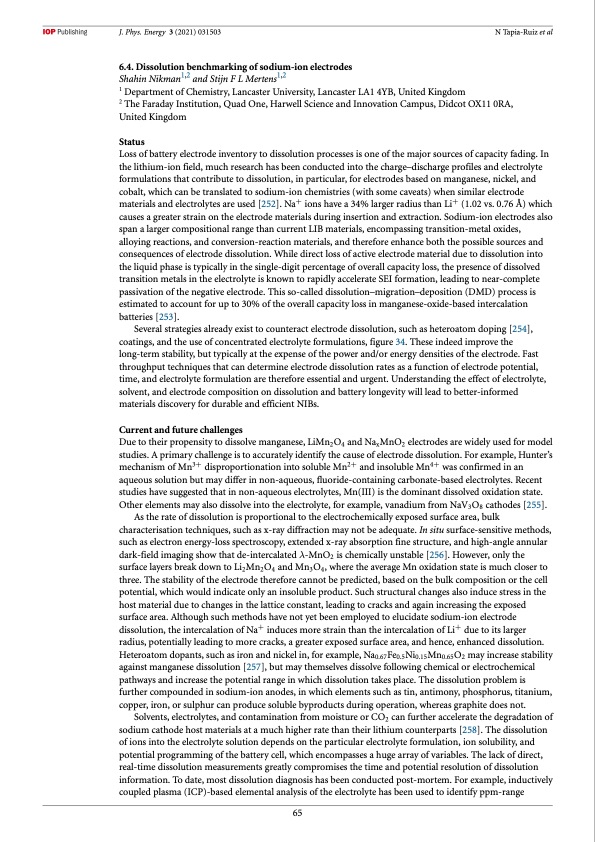
PDF Publication Title:
Text from PDF Page: 066
J. Phys. Energy 3 (2021) 031503 N Tapia-Ruiz et al 6.4. Dissolution benchmarking of sodium-ion electrodes Shahin Nikman1,2 and Stijn F L Mertens1,2 1 Department of Chemistry, Lancaster University, Lancaster LA1 4YB, United Kingdom 2 The Faraday Institution, Quad One, Harwell Science and Innovation Campus, Didcot OX11 0RA, United Kingdom Status Loss of battery electrode inventory to dissolution processes is one of the major sources of capacity fading. In the lithium-ion field, much research has been conducted into the charge–discharge profiles and electrolyte formulations that contribute to dissolution, in particular, for electrodes based on manganese, nickel, and cobalt, which can be translated to sodium-ion chemistries (with some caveats) when similar electrode materials and electrolytes are used [252]. Na+ ions have a 34% larger radius than Li+ (1.02 vs. 0.76 Å) which causes a greater strain on the electrode materials during insertion and extraction. Sodium-ion electrodes also span a larger compositional range than current LIB materials, encompassing transition-metal oxides, alloying reactions, and conversion-reaction materials, and therefore enhance both the possible sources and consequences of electrode dissolution. While direct loss of active electrode material due to dissolution into the liquid phase is typically in the single-digit percentage of overall capacity loss, the presence of dissolved transition metals in the electrolyte is known to rapidly accelerate SEI formation, leading to near-complete passivation of the negative electrode. This so-called dissolution–migration–deposition (DMD) process is estimated to account for up to 30% of the overall capacity loss in manganese-oxide-based intercalation batteries [253]. Several strategies already exist to counteract electrode dissolution, such as heteroatom doping [254], coatings, and the use of concentrated electrolyte formulations, figure 34. These indeed improve the long-term stability, but typically at the expense of the power and/or energy densities of the electrode. Fast throughput techniques that can determine electrode dissolution rates as a function of electrode potential, time, and electrolyte formulation are therefore essential and urgent. Understanding the effect of electrolyte, solvent, and electrode composition on dissolution and battery longevity will lead to better-informed materials discovery for durable and efficient NIBs. Current and future challenges Due to their propensity to dissolve manganese, LiMn2O4 and NaxMnO2 electrodes are widely used for model studies. A primary challenge is to accurately identify the cause of electrode dissolution. For example, Hunter’s mechanism of Mn3+ disproportionation into soluble Mn2+ and insoluble Mn4+ was confirmed in an aqueous solution but may differ in non-aqueous, fluoride-containing carbonate-based electrolytes. Recent studies have suggested that in non-aqueous electrolytes, Mn(III) is the dominant dissolved oxidation state. Other elements may also dissolve into the electrolyte, for example, vanadium from NaV3O8 cathodes [255]. As the rate of dissolution is proportional to the electrochemically exposed surface area, bulk characterisation techniques, such as x-ray diffraction may not be adequate. In situ surface-sensitive methods, such as electron energy-loss spectroscopy, extended x-ray absorption fine structure, and high-angle annular dark-field imaging show that de-intercalated λ-MnO2 is chemically unstable [256]. However, only the surface layers break down to Li2Mn2O4 and Mn3O4, where the average Mn oxidation state is much closer to three. The stability of the electrode therefore cannot be predicted, based on the bulk composition or the cell potential, which would indicate only an insoluble product. Such structural changes also induce stress in the host material due to changes in the lattice constant, leading to cracks and again increasing the exposed surface area. Although such methods have not yet been employed to elucidate sodium-ion electrode dissolution, the intercalation of Na+ induces more strain than the intercalation of Li+ due to its larger radius, potentially leading to more cracks, a greater exposed surface area, and hence, enhanced dissolution. Heteroatom dopants, such as iron and nickel in, for example, Na0.67Fe0.5Ni0.15Mn0.65O2 may increase stability against manganese dissolution [257], but may themselves dissolve following chemical or electrochemical pathways and increase the potential range in which dissolution takes place. The dissolution problem is further compounded in sodium-ion anodes, in which elements such as tin, antimony, phosphorus, titanium, copper, iron, or sulphur can produce soluble byproducts during operation, whereas graphite does not. Solvents, electrolytes, and contamination from moisture or CO2 can further accelerate the degradation of sodium cathode host materials at a much higher rate than their lithium counterparts [258]. The dissolution of ions into the electrolyte solution depends on the particular electrolyte formulation, ion solubility, and potential programming of the battery cell, which encompasses a huge array of variables. The lack of direct, real-time dissolution measurements greatly compromises the time and potential resolution of dissolution information. To date, most dissolution diagnosis has been conducted post-mortem. For example, inductively coupled plasma (ICP)-based elemental analysis of the electrolyte has been used to identify ppm-range 65PDF Image | 2021 roadmap for sodium-ion batteries

PDF Search Title:
2021 roadmap for sodium-ion batteriesOriginal File Name Searched:
roadmap-sodium-ion-batteries_031503.pdfDIY PDF Search: Google It | Yahoo | Bing
Salgenx Redox Flow Battery Technology: Salt water flow battery technology with low cost and great energy density that can be used for power storage and thermal storage. Let us de-risk your production using our license. Our aqueous flow battery is less cost than Tesla Megapack and available faster. Redox flow battery. No membrane needed like with Vanadium, or Bromine. Salgenx flow battery
| CONTACT TEL: 608-238-6001 Email: greg@salgenx.com | RSS | AMP |